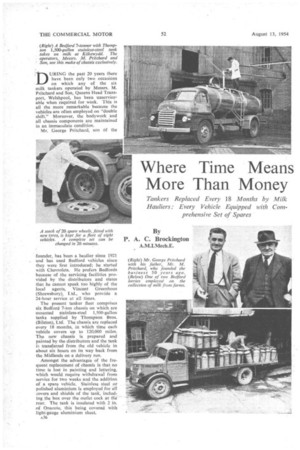Where Time Means More Than Money
Page 62

Page 63

If you've noticed an error in this article please click here to report it so we can fix it.
Tankers Replaced Every 18 Months by Milk Hauliers: Every Vehicle Equipped with Comprehensive Set of Spares
By P. A. C. Brockington A.M.I.Mech.E.
DTJRING the past 20 years there have been only two occasions on which any of the six milk tankers operated by Messrs. M. Pritchard and Son, Queens Head Transport, Welshpool, has been unserviceable when required for work. This is all the more remarkable because the vehicles are often employed on "double shift." Moreover, the bodywork and all chassis components are maintained in an immaculate condition. Mr. George Pritchard, son a the
founder, has been a haulier since 1921 and has used Bedford vehicles since they were first introduced; he started with Chevrolets. He prefers Bedfords because of the servicing facilities provided by the distributors and states that he cannot speak too highly of the local agents, Vincent Greenhous (Shrewsbury), Ltd., who provide a 24-hour service at all times.
The present tanker fleet comprises six Bedford 7-ton chassis on which are mounted stainless-steel 1,500-gallon tanks supplied by Thompson Bros. (Bilston), Ltd. The chassis are replaced every 18 months, in which time each vehicle covers up to 120,000 miles. The new chassis is prepared and painted by the distributors and the tank is transferred from the old vehicle in about six hours on its way back from the Midlands on a delivery run.
Amongst the advantages of the frequent replacement of chassis is that no time is lost in painting and lettering, which would require withdrawal from service for two weeks and the addition of a spare vehicle. Stainless steel or polished aluminium is employed for all covers and shields of the tank, including the box over the outlet cock at tlie" rear. The tank is insulated with 2 in. of Onazote, this being covered with light-gauge aluminium sheet.
A36
The most important aspect of Mr. Pritchard's maintenance policy is, in his own opinion, that all the tankers are equipped with a set of spare parts, including water and petrol pumps, a coil and distributor, fan belt, sparking plugs, bulbs and so on. Should a replacement be required, the work is carried out by the driver while his vehicle is being loaded or unloaded. If necessary, he would effect a replacement by the roadside.
The fact that the drivers are "the finest lot of men going" is obviously a qualifying factor of great importance. To their ability as mechanics, they add a willingness to do any job requested of them by the dairies and they carry a washleather, a sponge and brushes to clean the vehicle during their spare time.
In Mr, Pritchard's view, labour charges are too high to warrant " patching," and new parts are generally fitted in preference to an overhaul. Routine weekly servicing is performed by the drivers or by the two mechanics of Queens Head Garage, an associated concern. A number of reconditioned cylinder heads is kept in stock, and a replacement is made when attention is required to the valves. This task normally occupies something like two hours.
As an example of the capital cost of spares being setondary to the avoidance of waste time, a stock of 20 wheels, fitted with new tyres, is constantly maintained. When required, a complete set can be changed in 20 min.
A worn tyre is remoulded by the makers and is then employed on one of the collection vehicles. Tyres of the same make are always used on twinned wheels, which are occasionally interchanged to obtain even wear. The average mileage life of the tanker tyres is over 30,000
Spot Checks
Spot checks of greasing points, tyre pressures and so on are regularly made by Mr. Pritchard, who also tests the vehicles. Although the one-driver-onevehicle rule has to be modified to the requirements of shift work, every driver is allocated a tanker and is responsible for keeping it in perfect mechanical condition.
Although until recently it was necessary to replace an engine after the vehicle had covered about 70,000 miles, the use of Shell X100 semi-detergent oil promises to prolong engine life to the
full 18 months that a chassis is kept in service. Lubricated with this oil, the engine of one tanker, which had covered over 110,000 miles, showed
negligible bore wear, Engine oil of S.A.E. 40 viscosity is employed in summer, and an S.A.E. 30 oil in the winter, changes being made at 1,000mile intervals.
The milk is collected from the farms in churns by two Bedford 7-ton platform vehicles and delivered to a depot at Kilkewydd, where it is pumped into overhead tanks and later discharged into the tankers.. The collection radius is about 30 miles and the tanker radius about 110 miles, the centres to which deliveries are made including Birmingham, Wolverhampton, Loughborough, Liverpool, Frampton and Maulbrook.
The lorries are, in the main, subject to the same maintenance and renewal policy as the tanker chassis. The tankers average 19 m.p.g. and the lorries somewhat less.
Mr. M. Pritchard started as a haulier in the horse-and-cart days 50 years ago; he is still an active partner in the business. He has followed technical developments with interest and it is generally agreed that, as a driver, he is unexcelled,




























































































